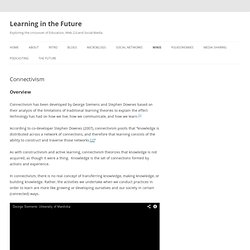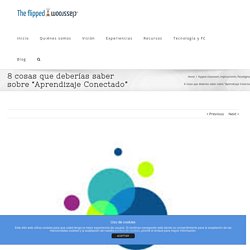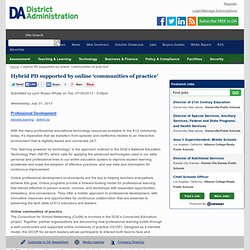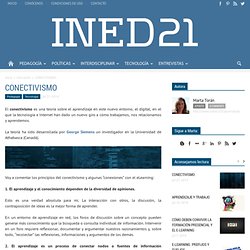

Connectivisme. Learning in the Future. Overview Connectivism has been developed by George Siemens and Stephen Downes based on their analysis of the limitations of traditional learning theories to explain the effect technology has had on how we live, how we communicate, and how we learn.[1] According to co-developer Stephen Downes (2007), connectivism posits that “knowledge is distributed across a network of connections, and therefore that learning consists of the ability to construct and traverse those networks.[2]” As with constructivism and active learning, connectivism theorizes that knowledge is not acquired, as though it were a thing.

Knowledge is the set of connections formed by actions and experience. In connectivism, there is no real concept of transferring knowledge, making knowledge, or building knowledge. Educationaltechnology - Best people known for Educationaltechnology on Wefollow. Learning in the Future. 8 cosas que deberías saber sobre “Aprendizaje Conectado” 1 ¿Qué es?

La educación superior está entrando en una fase nueva y evolutiva que se define por las conexiones entre todo y todos; es un ecosistema altamente conectado de tecnologías que apoyan el compartir, la colaboración y los vínculos globales para especialistas y estudiantes en todas las áreas de actividad. El aspecto clave de esta etapa educativa está yendo más allá de la noción que califica a las tecnologías de la información simplemente como medios para ofrecer contenidos y e-learning.
Lo que emerge hoy es el énfasis en la integración, que permite a todos los participantes en la educación superior ensamblar componentes de una forma única, con el fin de construir las vías necesarias para lograr sus metas educativas. Este cambio en la educación superior permite al estudiante integrar únicamente las conexiones personales, las experiencias en clase y fuera de la clase, las colaboraciones y otros recursos de todo tipo. 2 ¿Cómo funciona?
3 ¿Quién lo está haciendo? Hybrid PD supported by online ‘communities of practice’ With the many professional educational technology resources available to the K12 community today, it’s imperative that we transition from episodic and ineffective models to an interactive environment that is digitally-based and connected 24/7.

This “learning powered by technology” is the approach outlined in the DOE’s National Education Technology Plan (NETP), which calls for applying the advanced technologies used in our daily personal and professional lives to our entire education system to improve student learning; accelerate and scale the adoption of effective practices; and use data and information for continuous improvement. Online professional development environments are the key to helping teachers everywhere achieve this goal. Online programs provide a forward-looking model for professional learning that blends effective in-person events, courses, and workshops with expanded opportunities, immediacy, and convenience. Online communities of practice.
Accessing knowledge. Connectivism and Communities of Practice. The term Knowledge Management has traditionally referred to ongoing efforts to harness explicit and tacit knowledge within an organisation while 'organisational learning' tends to be more focussed on static efforts to meet specific learning objectives.

Recently, the lines have become blurred to the extent that a merger in strategies should be considered by any organisation serious about harnessing knowledge and promoting learning. Siemens' article, 'Connectivism: A Learning Theory for the Digital Age', discusses the need for 'a theory that attempts to explain the link between individual and organizational learning' (Siemens, 2004). He expands his theory of networked learning further in his article ‘Connectivism: Learning as Network-Creation’ (Siemens, 2005). I will demonstrate that the theories outlined in Siemens’ two articles are aligned with Wenger’s attempts to rethink learning in the shape of Communities of Practice (CoP).
References: Pór. Siemens. Siemens. Wenger. Wenger. CONECTIVISMO. El conectivismo es una teoría sobre el aprendizaje en este nuevo entorno, el digital, en el que la tecnología e Internet han dado un nuevo giro a cómo trabajamos, nos relacionamos y aprendemos.

Theflippedclassroom. Connected Learning. A Comprehensive Checklist of The 21st Century Learning and Work Skills. July 16, 2014 While searching for some resources on a paper and writing on the 21st century learning skills I came across this skills checklist created by the university of UToledo.

This checklist is meant to help students build powerful resumes outlining all the skills they master. I spent some time going through the components of this sheet and found it really sharing with you here. You can use this sheet with your students as an explanatory guide of some of the important skills ( I said some because some other important skills particularly those related to digital citizenship and digital literacy are missing) they need to work. Below is a round-up of the 9 most important skills which I selected from the entire list. You can access this list from this link. 1- Research skills. 20140710 beyondinstitutions personallearninginanetworkedworld 140709043853 phpapp01. Beyond institutions - personal learning in a networked world.